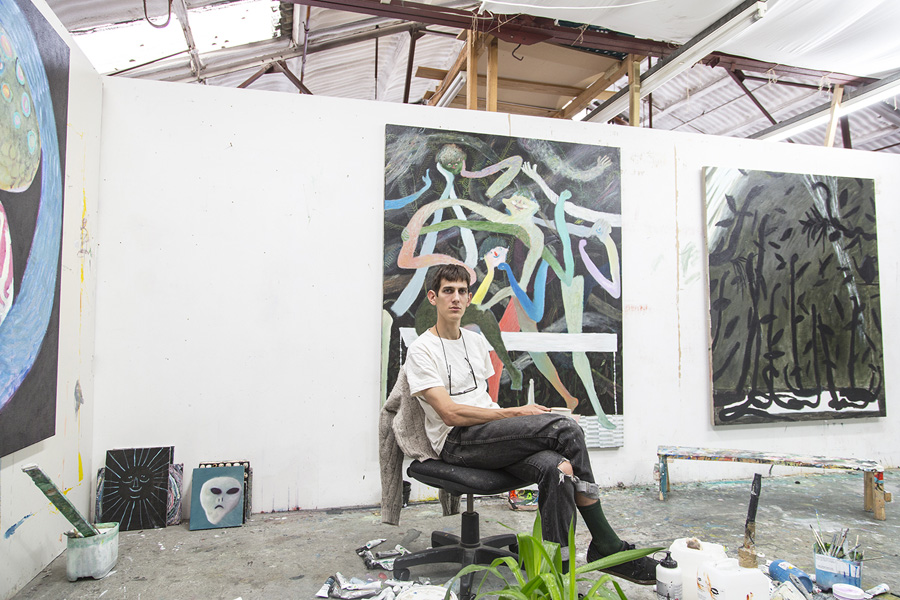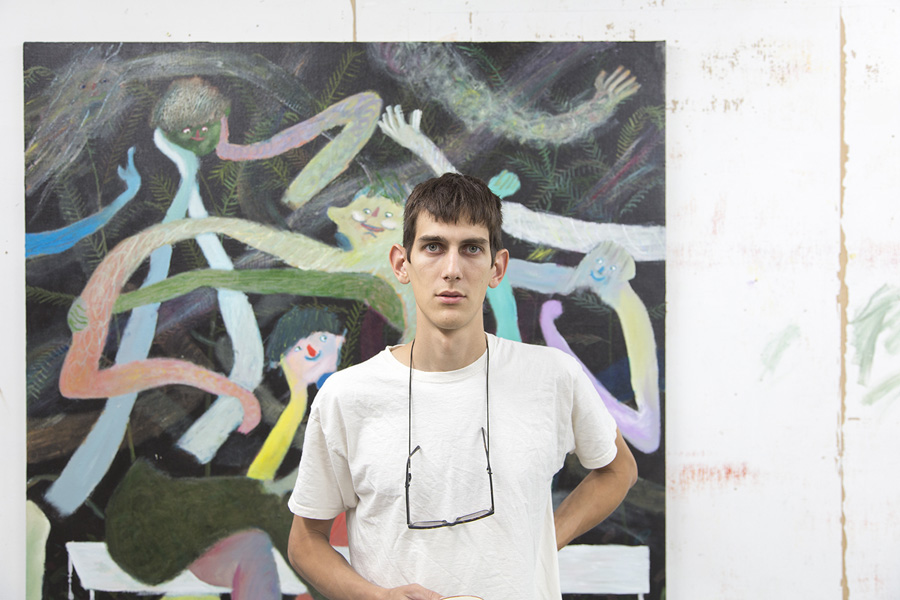Artists / Exhibition History / Art Fairs / Contact |
2018 / 2017 / 2016 / 2015 / 2014 / 2013 / 2012 / 2011 / 2010 / 2009 / All |
|
Tom Howse |
|
Selected press: Tom Howse Interview / Artviewer |
“The aim is what’s best for the painting at the end of the day and nothing else. |
 |
Ahead of his solo show “Post-Celestial Compost” at Rod Barton in September 2017, Gallery Assistant Steve Fuller met with painter Tom Howse in his London studio to discuss his large-scale surreal paintings, his approach to his own work and it’s subsequent reception. Steve Fuller: Considering that you’re currently in a place of upheaval, currently moving studio, how did you find yourself here in London from your native Chester and where do you see yourself working in the future? Tom Howse: I moved to London in order to study around 9 - 10 years ago. Staying in London just seemed more relevant. Where else are you going to go? I’d like in the future to not to have to pay so much money for such little space. I’d like to own big things that can just sit dormant in a big place. It’s not vanity of a large house or owning a big car. However, I’d like space to grow plants everywhere and have a herd of cats running around. SF: That physicality of space comes into your work. You’ve previously discussed how you seem to paint at life- size, at an almost 1:1 ratio. Where a doorframe is something to walk through or real-life furnishings part of a legitimate interiors. Has this been an organic process or is it a deliberate compositional decision? TH: It definitely came about quite organically, I didn’t intend for it to be that way. It just is that way. Maybe there is something in having paintings that work on a life-scale. It makes them more believable somehow? There’s something more intrinsic to your sense of humanity within them. SF: Do you think this helps your paintings to avoid the kitsch and the catch-all term of “otherworldly?” SF: So you feel like it’s successful in avoiding the kitsch? TH: I think so. As a painter, I don’t set out to make “wacky” paintings. I’m dead serious about them. They make me laugh because they have this comedy of the absurd. But, breaking through the surface humour and getting affected by the subject-matter of weirdness it becomes like an Escher drawing. It loops. You kind of keep going into and into and into it. SF: These absurd figures and motifs, whether teapots or a sun with a face, feel less Alice in Wonderland and more your own visual language. Can you discuss their position in your work, and how and why you utilise them? TH: It began when I started making ceramics. Previously, when I’d be drawing or sketching out a painting, I’d spend about half an hour drawing. All of a sudden, doing pottery and throwing clay on a wheel, you’re paying the same amount of time and attention to the drawing, but focused on a single line. Or at least it took me that long because I’m a bit crap at it. I remember watching an interview with a potter talking about the work of Bernard Leech and Masatoshi Hamada, where he talked about the anthropological terms of earthenware, I was blown away by someone describing the “tension” in bowl and emotional attachments through these objects; although these forms are lifeless, these objects have feeling, and these feelings exist and give life in an image. SF: I think tension is a great route into your work. Within your painting there is a very visual tension. A threat of escapism. TH: Yes, there is a polite degree of composition but there is also a side that is anxious and uncomfortable within my work and the compositions. They almost have flat planes stacked together as opposed to a singular vanishing point. Even in some paintings that have more depth to them, it feels very artificial. The depth itself feels like another object; like a barren infinity for ideas to congregate, where tension of entrapment is able to react. SF: The tension comes a lot into your work via the use of colour. There’s a lot of blacks and heavy thick colouring often juxtaposed with more nuanced, natural colourings. TH: Absolutely, I feel I’ve purged that reliance on full “mad” colour saturation from my work and my handling. Whilst I want my paintings’ protagonists to be the shiniest fairy on the Christmas tree, they’re not, and that is somehow more real and allows me to avoid the “otherworldly” distinction. I feel I am gradually learning that making something more real can be the thing that makes something more weird, and the perhaps infact quite unreal. SF: I guess this is a good point to start talking about your process and how you go about the act of constructing a painting. How do you go about the action of planning a painting? TF: Well, I do loads of drawing. Loads of sketchbook work. It used to be the case I’d do “x” amount of drawings in my sketchbook and the next painting was just the next drawing. It would either work or wouldn’t. The worst paintings are the ones where the drawing was perfect initially whereas the most successful paintings require me to get stuck and force change in order to force momentum forwards. There’s nothing wrong with effortless painting. I don’t want to suggest that I am somehow better for having suffered somewhat. SF: So you’re saying you don’t necessarily buy into the idea of a reputation based economy in struggle? That somehow the work is more valid because of the struggle involved in it’s production? TH: There is no glory in making things harder for yourself than they need to be, no. Struggle either is or isn’t, there’s no currency in it. If you need to do it, get on with it, it shouldn’t be the case of “well done you.” The aim is what’s best for the painting at the end of the day and nothing else. Anything else, I honestly don’t care about. Painting is just hard work, and that’s really all it is. The paintings work because what needs to happen is done. SF: So, in regards to working beyond the reception of your work, are there criticisms of your practice you deem unfair or find irritating?” TH: Often what’s most frustrating is when people aren’t criticising the work but actually saying they like the paintings. It’s not a case of judging people and being a snob, but there are some moments where the reasons people like your work feels wrong to you as an artist. “Fun“, “happy“ and “wacky“, are often words that I find frustrating when used to describe my work. It seems like a very base-level façade of reading the work. So, sometimes when I receive those compliments, it feels like only the first 1% of the painting has been assessed. SF: Finally, does your Mum like your work? TH: Ha! Hit and miss. She likes colour, but she doesn’t like the black ones. Her exact quote was “I can’t wait for you to get over this!” |
|
Tom Howse in his studio, August 2017 |
